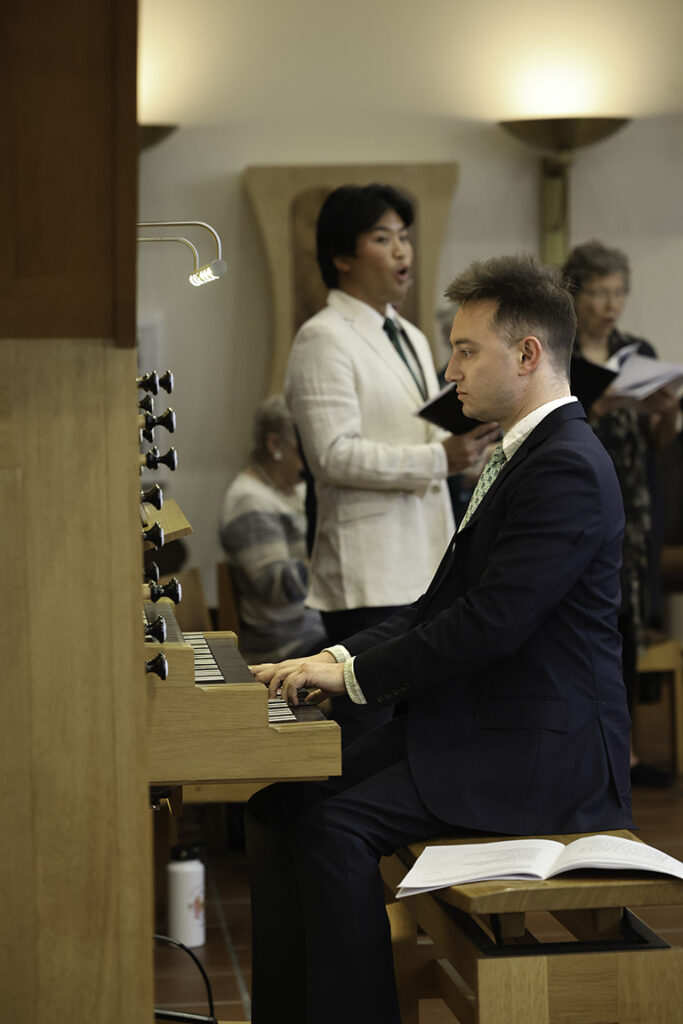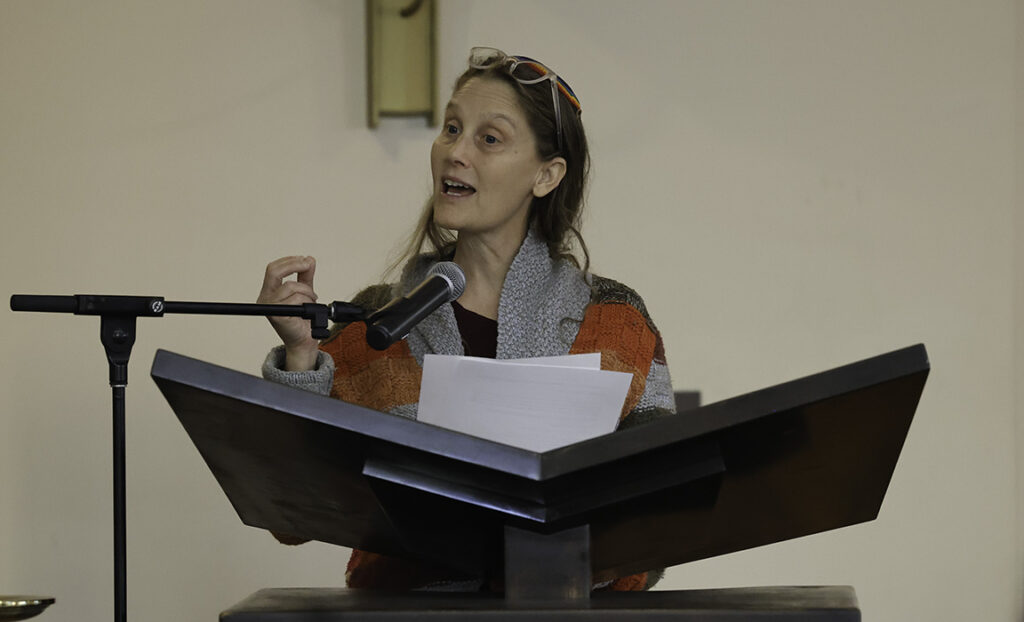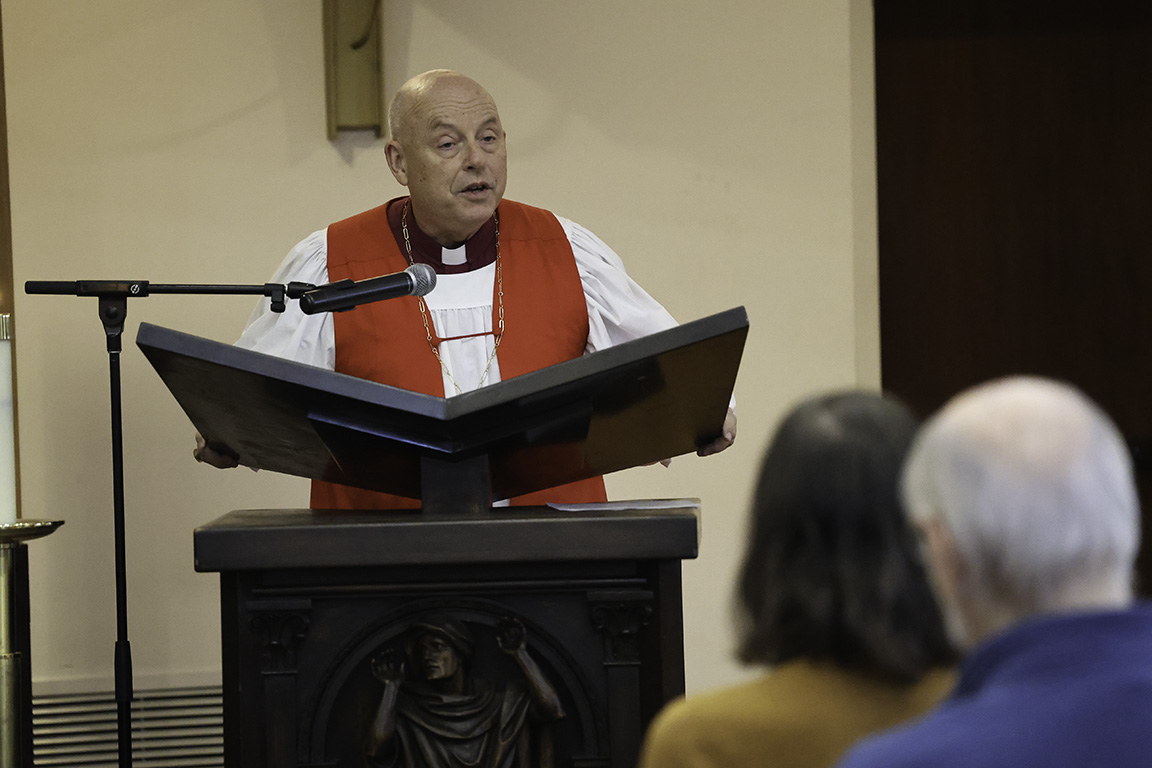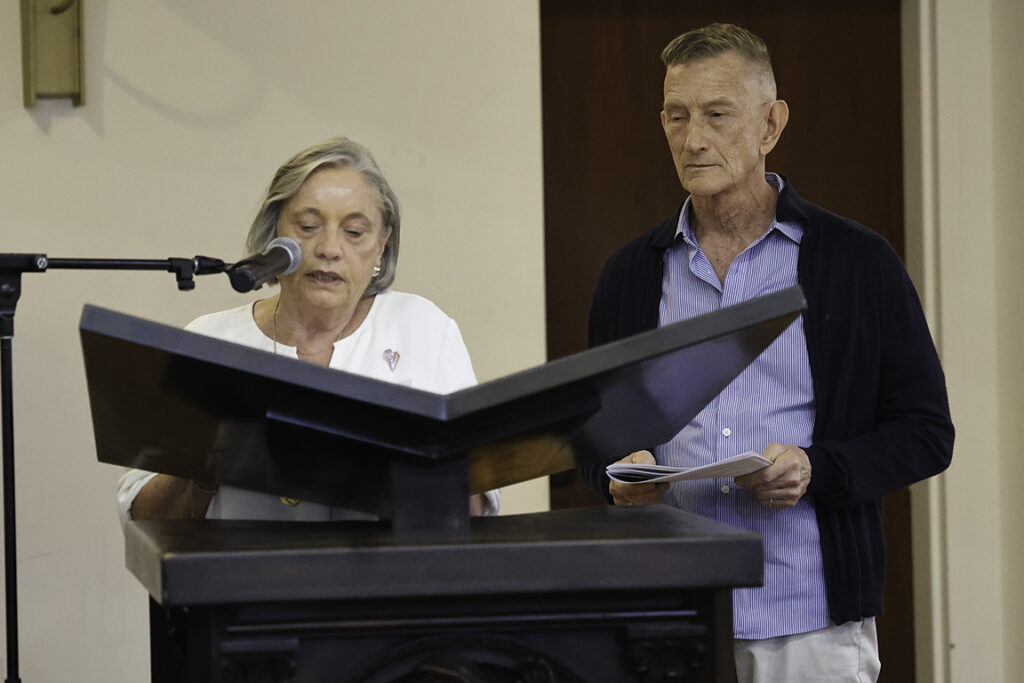
Singers from several congregations sing at the anniversary Evensong at St. Paul’s Commons on Oct. 20. Photos: Janet Kawamoto

Evan J. Griffith, music minister at St. Athanasius’ Church, played the organ and directed the choir at the anniversary service.
[The Episcopal News] A joyous spirit filled St. Athanasius Church in Echo Park Oct. 20 as Episcopalians and interfaith partners gathered for a choral Evensong commemorating the 30th anniversary of the campus’s consecration and the church’s 160th year of continuing ministry, making it the oldest Protestant church in Southern California.
“Making All Things New” was the celebratory theme in 1994 when the campus was consecrated as a place of great hospitality and service, a tradition that continues today, said Bishop John Harvey Taylor, who preached at the anniversary service.
“This evening, as the vesper light gathers, we are celebrating the 30th anniversary of a building dedicated in 1994 as the Cathedral Center of St. Paul, named for our former Cathedral in downtown Los Angeles. For most of its life, it’s been a sturdy headquarters for the Episcopal Diocese of Los Angeles, and that it remains,” Taylor told the gathering.
“This is a both-and scenario,” he added, “because we’ve made some new friends along the way, we’ve acquired a new name, and a new mission, in keeping with the large footprint of Episcopal identity.”
The campus is also home to the Immaculate Heart Community, a nonprofit ecumenical social justice organization; gatherings of NewGround: A Muslim-Jewish Partnership for Change; and Nefesh, a vibrant, growing synagogue, whose ark of Torah scrolls shares space near the altar.

Bishop John Harvey Taylor, left, preached at the service; John Watson, priest-in-charge of St. Athanasius Church, officiated.
Rabbi Susan Goldberg of Nefesh offered “gratitude for the leadership of this space. I can tell you that every day this is a space led by people whose hearts move them to give.”
With real connection comes intimacy and the creation of sacred space when “each person brings an offering of their heart … this is how we will build a sacred space together.”
“Just this week, there was weaving of the Immaculate Heart Community,” she said. “There was a food bank downstairs. Just a few days ago, people, Muslims and Jews, gathering here, remembering a horrible anniversary of a deadly year in prayer together. And then, up on the roof, … we are in the midst of the festival of booths, Sukkot, so we have a sukkah (hut) up on the roof where we celebrated.
“So many possibilities unfolding already, and so many possibilities in the future of this space. Now we are in a place, thank God, of imagining and dreaming. That is what we are doing here.”
Goldberg offered a blessing of peace: “May it be your will, God of our fathers and mothers, that this year brings a pervasive and complete peace. May it bring peace on all inhabitants of the earth, beyond all dreams of humanity. May all who lead the space continue to lead from their hearts and may it be a sacred space for those who are there and those who are coming, and the communities all around us.”

Rabbi Susan Goldberg of Nefesh, a synagogue congregation, offers thanks for the space they share with other organizations at St. Paul’s Commons.
Taylor also referred to the deepening partnership, recalling a recent Yom Kippur service hosted by Nefesh. Although a day of atonement, rather than a somber occasion, “We were telling the truth about our shortcomings, and we were dancing in the aisle,” he said.
“Almost everyone wore white, like a wedding, like a party at the foot of the holy mountain. Congregants danced in the aisles to music that, at times, verged on the ecstatic and yet the high holy day was the annual atonement fast, and the catalogue of sins in the written liturgy was prodigious.”
If Christians “found it a little easier to spell atonement ‘j-o-y,’ perhaps we would have done a little less damage across the centuries,” he added. “Maybe we wouldn’t have built our cathedrals by monetizing people’s guilt and shame, brick by brick, in a nation some insist is supposed to be rooted in Christian values. We might not have helped create a jail and prison system channeling all of our Protestant rectitude that’s rooted in vengeance instead of rehabilitation, twinning incarceration with cruel degradation. Instead, let us be joyful in our repentance.”
The occasion was “a happiness and a blessing together in the afternoon, in the evening, to pray the prayers and sing the songs and dance in the aisles, if we are so moved; to take stock of where we’ve been and abide in the assurance that our God, in Christ, is indeed making all things new. Enabling new ways to glorify God and care for God’s people, because we’re all on the road to the Promised Land. You and I, sojourners and pilgrims … we are all works in progress.”

Bishop John Harvey Taylor preaches at the anniversary service.
Noting the Old Testament lesson from Jeremiah 29:1, 4-14, addressed to those exiled in Babylon, and filled with God’s promises to restore their fortunes and return them home, Taylor said among church people sometimes there is a tendency to behave as if “we have reached our destination.
“We have our church. We have our friends. The services are always at the same time … we do these ministries we’ve been doing for ages in the same way. We’re (so) prone to work hard to maintain and protect what we have that we may miss what God is making new.
“So, when we listen to the prophets and their stories of exile, it is sometimes useful to think of ourselves as being in exile, still the ones on their way back to the Promised Land – still needing to make our way back across the desert to the temple,” Taylor said.
“Then Jeremiah says this impossible thing. The prophet says to take and seek the welfare of that very city into which God has sent us in captivity, to seek the welfare of Babylon because, as the prophet says, in its welfare, you will find your welfare. Go into the heart of enemy territory and save yourself by shining the light of love.”
Given current political divisiveness amid the upcoming election and social challenges, the prophet’s message, “in practical political terms, means to promote pluralism in the city, to promote true democracy, freedom and justice for all, at the very least,” he said. “Not resting until everyone in the city has enough to eat and a place to lay their head.”

Leading prayers are Dr. Sherry Purcell (left), president of the Immaculate Heart Community, and Steven Price, lay leader of Holy Spirit Community.
Taylor added: “People are as spiritually hungry as they’ve ever been and they’ll be encouraged in their better instincts when people of faith speak up for our values and act in accordance with the values we proclaim, especially when we manage to see beyond our differences of faith, our differences of doctrine and model unity in a world that needs it desperately.”
The Rev. John Watson, priest-in-charge of St. Athanasius, officiated at the Evensong service; a volunteer choir representing several church of the diocese offered music, accompanied by organist and choir director Evan J. Griffith. The Rev. René Barraza, a former St. Athanasius vicar and current assisting priest, also participated in the service, along members of the Holy Spirit church community, and others.
St. Athanasius’s first service was held in the pueblo’s Odd Fellows Hall on Christmas Day 1864, according to Canon for Common Life Bob Williams, diocesan historian-archivist.
Highlights of the church’s early years include rector Elias Birdsall’s local eulogy for President Abraham Lincoln; the parish’s operating of St. Paul’s Hospital, later named Good Samaritan; and the church’s ownership of 35 acres of downtown real estate.
Other milestones include the parish’s 1883 renaming of St. Paul’s, the church’s 1899 designation as pro-cathedral of the Diocese of Los Angeles, the 1896 re-organization of the church in L.A.’s Temple-Beaudry district and its 1971 move to 840 Echo Park, its current location.
Also notable: the 1924 construction of St. Paul’s Cathedral on Figueroa near Wilshire, (demolished in 1980 after earthquake damage), the 1989 reunion of ministries as Echo Park’s Parish of St. Athanasius & St. Paul, and the 1994 dedication on the site of the Cathedral Center of St. Paul as diocesan headquarters.
